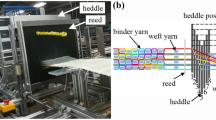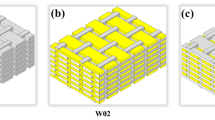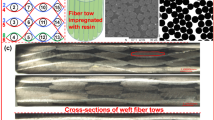Abstract
In this study, the behavior of 2D and 3D woven composites is compared under low velocity impact. Several 2D and 3D specimens were tested using a drop-weight tower, and their performance was compared using extracted data such as damage threshold load, damage initiation time, absorbed energy and maximum deflection. Besides, their damage modes and delamination areas were examined by stereomicroscope and C-scan technique, respectively. The results showed that the 3D woven composites absorbed more impact energy than 2D ones while their maximum deflection was lower. Moreover, the delamination and damage areas were much smaller in the 3D composites than the 2D ones of similar thickness. A new parameter is presented for comparing damage severity of the 2D and 3D composites. Unlike conventional parameters, the presented one shows potential for being applicable to laminated composites, regardless of their areal densities, layer numbers and weave structures.

















Similar content being viewed by others
References
Mahmood A, Wang X, Zhou C (2013) Generic stiffness model for 3D woven orthogonal hybrid composites. Aerosp Sci Technol 31:42–52. https://doi.org/10.1016/j.ast.2013.09.005
Esmaeeli M, Kazemianfar B, Nami MR (2019) Simultaneous optimization of elastic constants of laminated composites using artificial bee colony algorithm. Adv Compos Hybrid Mater 2:431–443. https://doi.org/10.1007/s42114-019-00106-7
Sarasini F, Tirillò J, Ferrante L et al (2014) Drop-weight impact behaviour of woven hybrid basalt–carbon/epoxy composites. Compos B Eng 59:204–220. https://doi.org/10.1016/j.compositesb.2013.12.006
Grasso M, Xu Y, Ramji A et al (2019) Low-velocity impact behaviour of woven laminate plates with fire retardant resin. Compos B Eng 171:1–8. https://doi.org/10.1016/j.compositesb.2019.04.023
Miao H, Wu Z, Ying Z, Hu X (2019) The numerical and experimental investigation on low-velocity impact response of composite panels: effect of fabric architecture. Compos Struct 227:111343. https://doi.org/10.1016/j.compstruct.2019.111343
Yang C-H, Ma W-N, Ma D-W (2018) Low-velocity impact analysis of carbon nanotube reinforced composite laminates. J Mater Sci 53:637–656. https://doi.org/10.1007/s10853-017-1538-z
Zhang C, Curiel-Sosa JL, Duodu EA (2017) Finite element analysis of the damage mechanism of 3D braided composites under high-velocity impact. J Mater Sci 52:4658–4674. https://doi.org/10.1007/s10853-016-0709-7
Kaboglu C, Mohagheghian I, Zhou J et al (2018) High-velocity impact deformation and perforation of fibre metal laminates. J Mater Sci 53:4209–4228. https://doi.org/10.1007/s10853-017-1871-2
Chogani A, Moosavi A, Rahiminejad M (2016) Numerical simulation of salt water passing mechanism through nanoporous single-layer graphene membrane. Chem Prod Process Model 11:73. https://doi.org/10.1515/cppm-2015-0068
Esmaeeli M, Nami MR, Kazemianfar B (2019) Geometric analysis and constrained optimization of woven z-pinned composites for maximization of elastic properties. Compos Struct 210:553–566. https://doi.org/10.1016/j.compstruct.2018.11.070
Chun H-J, Son J, Kang K-T et al (2014) Prediction of elastic properties for woven z-pinned composites. Compos B Eng 64:59–71. https://doi.org/10.1016/j.compositesb.2014.04.010
Mouritz AP (2008) Tensile fatigue properties of 3D composites with through-thickness reinforcement. Compos Sci Technol 68:2503–2510. https://doi.org/10.1016/j.compscitech.2008.05.003
Zhou L, Zeng J, Jiang L, Hu H (2018) Low-velocity impact properties of 3D auxetic textile composite. J Mater Sci 53:3899–3914. https://doi.org/10.1007/s10853-017-1789-8
Zikray MA, Baucom JB (2003) Evolution of failure mechanism in 2D and 3D woven composites system under quasi-static perforation. J Compos Mater 37:1651. https://doi.org/10.1177/002199803035178
Baucom JN, Zikry MA, Qiu Y (2004) Dynamic and quasi-static failure evolution of 3D woven cellular composite systems. J Reinf Plast Compos 23:471–481. https://doi.org/10.1177/0731684404032076
Baucom JN, Zikry MA (2005) Low-velocity impact damage progression in woven E-glass composite systems. Compos A Appl Sci Manuf 36:658–664. https://doi.org/10.1016/j.compositesa.2004.07.008
Baucom JN, Zikry MA, Rajendran AM (2006) Low-velocity impact damage accumulation in woven S2-glass composite systems. Compos Sci Technol 66:1229–1238. https://doi.org/10.1016/j.compscitech.2005.11.005
Gerlach R, Siviour CR, Wiegand J, Petrinic N (2012) In-plane and through-thickness properties, failure modes, damage and delamination in 3D woven carbon fibre composites subjected to impact loading. Compos Sci Technol 72:397–411. https://doi.org/10.1016/j.compscitech.2011.11.032
Castaneda N, Wisner B, Cuadra J et al (2017) Investigation of the Z-binder role in progressive damage of 3D woven composites. Compos A Appl Sci Manuf 98:76–89. https://doi.org/10.1016/j.compositesa.2016.11.022
Pankow M, Waas AM, Yen CF, Ghiorse S (2011) Shock loading of 3D woven composites: a validated finite element investigation. Compos Struct 93:1347–1362. https://doi.org/10.1016/j.compstruct.2010.11.001
Behera BK, Dash BP (2015) Mechanical behavior of 3D woven composites. Mater Des 67:261–271. https://doi.org/10.1016/j.matdes.2014.11.020
Saleh MN, El-Dessouky HM, Saeedifar M et al (2019) Compression after multiple low velocity impacts of NCF, 2D and 3D woven composites. Compos A Appl Sci Manuf 125:105576. https://doi.org/10.1016/j.compositesa.2019.105576
Bandaru AK, Chavan VV, Ahmad S et al (2016) Low velocity impact response of 2D and 3D Kevlar/polypropylene composites. Int J Impact Eng 93:136–143. https://doi.org/10.1016/j.ijimpeng.2016.02.016
Bandaru AK, Chavan VV, Ahmad S et al (2016) Ballistic impact response of Kevlar® reinforced thermoplastic composite armors. Int J Impact Eng 89:1–13. https://doi.org/10.1016/j.ijimpeng.2015.10.014
Bandaru AK, Patel S, Sachan Y et al (2016) Low velocity impact response of 3D angle-interlock Kevlar/basalt reinforced polypropylene composites. Mater Des 105:323–332. https://doi.org/10.1016/j.matdes.2016.05.075
Bandaru AK, Sachan Y, Ahmad S et al (2017) On the mechanical response of 2D plain woven and 3D angle-interlock fabrics. Compos B Eng 118:135–148. https://doi.org/10.1016/j.compositesb.2017.03.011
Thorsson SI, Sringeri SP, Waas AM et al (2018) Experimental investigation of composite laminates subject to low-velocity edge-on impact and compression after impact. Compos Struct 186:335–346. https://doi.org/10.1016/j.compstruct.2017.11.084
Pankow M, Waas AM, Yen CF, Ghiorse S (2012) Modeling the response, strength and degradation of 3D woven composites subjected to high rate loading. Compos Struct 94:1590–1604. https://doi.org/10.1016/j.compstruct.2011.12.010
Wang J, Waas AM, Wang H (2013) Experimental and numerical study on the low-velocity impact behavior of foam-core sandwich panels. Compos Struct 96:298–311. https://doi.org/10.1016/j.compstruct.2012.09.002
Thorsson SI, Waas AM, Rassaian M (2018) Low-velocity impact predictions of composite laminates using a continuum shell based modeling approach part A: impact study. Int J Solids Struct 155:185–200. https://doi.org/10.1016/j.ijsolstr.2018.07.020
Zabala H, Aretxabaleta L, Castillo G et al (2014) Impact velocity effect on the delamination of woven carbon–epoxy plates subjected to low-velocity equienergetic impact loads. Compos Sci Technol 94:48–53. https://doi.org/10.1016/j.compscitech.2014.01.016
Suresh Kumar C, Arumugam V, Dhakal HN, John R (2015) Effect of temperature and hybridisation on the low velocity impact behavior of hemp-basalt/epoxy composites. Compos Struct 125:407–416. https://doi.org/10.1016/j.compstruct.2015.01.037
Belingardi G, Vadori R (2003) Influence of the laminate thickness in low velocity impact behavior of composite material plate. Compos Struct 61:27–38. https://doi.org/10.1016/S0263-8223(03)00027-8
Wang Y, Zhang J, Fang G et al (2018) Influence of temperature on the impact behavior of woven-ply carbon fiber reinforced thermoplastic composites. Compos Struct 185:435–445. https://doi.org/10.1016/j.compstruct.2017.11.056
Mitrevski T, Marshall IH, Thomson R et al (2005) The effect of impactor shape on the impact response of composite laminates. Compos Struct 67:139–148. https://doi.org/10.1016/j.compstruct.2004.09.007
Sultan MTH, Worden K, Staszewski WJ, Hodzic A (2012) Impact damage characterisation of composite laminates using a statistical approach. Compos Sci Technol 72:1108–1120. https://doi.org/10.1016/j.compscitech.2012.01.019
Sevkat E, Liaw B, Delale F, Raju BB (2010) Effect of repeated impacts on the response of plain-woven hybrid composites. Compos B Eng 41:403–413. https://doi.org/10.1016/j.compositesb.2010.01.001
Zhang D, Sun Y, Chen L, Pan N (2013) A comparative study on low-velocity impact response of fabric composite laminates. Mater Des 50:750–756. https://doi.org/10.1016/j.matdes.2013.03.044
Shyr T-W, Pan Y-H (2003) Impact resistance and damage characteristics of composite laminates. Compos Struct 62:193–203. https://doi.org/10.1016/S0263-8223(03)00114-4
Hossain ME, Hossain MK, Hosur M, Jeelani S (2014) Low-velocity impact behavior of CNF-filled glass-reinforced polyester composites. J Compos Mater 48:879–896. https://doi.org/10.1177/0021998313480194
Abdallah EA, Bouvet C, Rivallant S et al (2009) Experimental analysis of damage creation and permanent indentation on highly oriented plates. Compos Sci Technol 69:1238–1245. https://doi.org/10.1016/j.compscitech.2009.02.029
Matadi Boumbimba R, Coulibaly M, Khabouchi A et al (2017) Glass fibres reinforced acrylic thermoplastic resin-based tri-block copolymers composites: low velocity impact response at various temperatures. Compos Struct 160:939–951. https://doi.org/10.1016/j.compstruct.2016.10.127
Mitrevski T, Marshall IH, Thomson RS, Jones R (2006) Low-velocity impacts on preloaded GFRP specimens with various impactor shapes. Compos Struct 76:209–217. https://doi.org/10.1016/j.compstruct.2006.06.033
Hosur MV, Adbullah M, Jeelani S (2005) Studies on the low-velocity impact response of woven hybrid composites. Compos Struct 67:253–262. https://doi.org/10.1016/j.compstruct.2004.07.024
Evci C, Gülgeç M (2012) An experimental investigation on the impact response of composite materials. Int J Impact Eng 43:40–51. https://doi.org/10.1016/j.ijimpeng.2011.11.009
Brostow W, Hagg Lobland HE (2010) Brittleness of materials: implications for composites and a relation to impact strength. J Mater Sci 45:242–250. https://doi.org/10.1007/s10853-009-3926-5
Minak G, Ghelli D (2008) Influence of diameter and boundary conditions on low velocity impact response of CFRP circular laminated plates. Compos B Eng 39:962–972. https://doi.org/10.1016/j.compositesb.2008.01.001
Lee SH, Waas AM (1999) Compressive response and failure of fiber reinforced unidirectional composites. Int J Fract 100:275–306. https://doi.org/10.1023/A:1018779307931
Author information
Authors and Affiliations
Corresponding author
Ethics declarations
Conflict of interest
The authors declare that they have no conflict of interest.
Data availability
The raw data required to reproduce these findings are available to download from [https://doi.org/10.17632/p95kc5tskb.2].
Additional information
Publisher's Note
Springer Nature remains neutral with regard to jurisdictional claims in published maps and institutional affiliations.
Rights and permissions
About this article
Cite this article
Kazemianfar, B., Esmaeeli, M. & Nami, M.R. Experimental investigation on response and failure modes of 2D and 3D woven composites under low velocity impact. J Mater Sci 55, 1069–1091 (2020). https://doi.org/10.1007/s10853-019-04096-1
Received:
Accepted:
Published:
Issue Date:
DOI: https://doi.org/10.1007/s10853-019-04096-1




